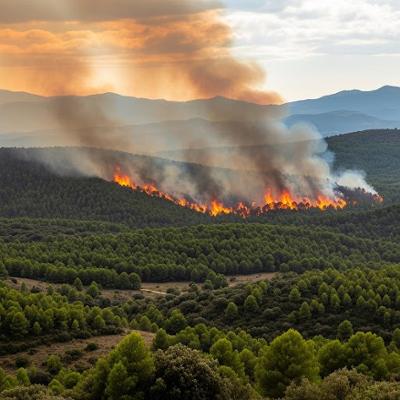

The high risk of wildfires requires strengthened prevention
The Government of Spain activated the national wildfire response plan in early June, reinforcing the resources of regional governments with additional human and technical support, thanks to an investment exceeding €115 million.
However, Tecnifuego warns that responsibility cannot fall solely on public administrations. “Prevention, infrastructure adaptation, landscape planning and public awareness must be key pillars of an effective response to this growing threat.”
With the official start of summer and weather forecasts predicting unusually high temperatures in the coming months, the Spanish Association of Fire Protection Companies (Tecnifuego) is calling for prevention and collective responsibility in the face of what is expected to be a particularly challenging wildfire season. In addition to the structural threat of climate change, this year’s exceptionally rainy spring has led to abundant vegetation growth in forests and woodlands, increasing the available fuel load and elevating the risk during the forecasted heatwaves.
The Spanish Government preemptively activated the national wildfire response plan in early June, which will remain in effect until 31 October. This plan boosts the capacity of regional governments with additional personnel and equipment, supported by an investment of over €115 million. However, as Tecnifuego reminds us, the responsibility cannot fall solely on public administrations. “Prevention, infrastructure adaptation, landscape planning, and public awareness must be core elements of an effective response to this escalating threat.”
Positive figures
Despite encouraging data from the Ministry for the Ecological Transition and the Demographic Challenge—with 47,711 hectares burned, the lowest figure since 2018—and a 52.7% reduction in burned area through May 2025 compared to the same period in 2024, the risk remains latent. “These are hopeful numbers, but we must not let our guard down,” warns Ramon Maria Bosch, coordinator of Tecnifuego’s specialized wildfire committee. “The threat of Large Wildfires (LWs) is still very real, and their behaviour is increasingly extreme and unpredictable.”
Tecnifuego also stresses that most wildfires in Spain are human-caused, whether through negligence or intentional acts. “It’s not enough to have firefighting resources—we must prevent fires from starting.”
Getting Ahead of the Fire
To prepare for the possibility of large wildfires, Tecnifuego recommends action on three levels: landscape planning, building adaptation and public education. Experts emphasise that landscape planning is becoming increasingly important in the face of climate change, as it helps reduce vegetation continuity, diversify land use, and create natural or strategic barriers that hinder fire spread. Special attention must be paid to wildland-urban interface (WUI) areas, where inhabited zones meet forested land—dramatically increasing the risk of fire impact.





